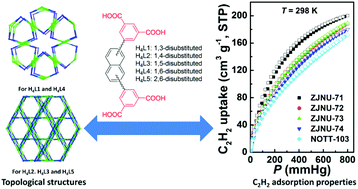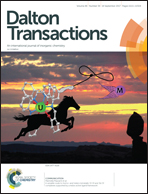A comparative study of C2H2 adsorption properties in five isomeric copper-based MOFs based on naphthalene-derived diisophthalates†
Abstract
In this work, five positional isomeric ligands consisting of two peripheral isophthalate moieties attached to the central naphthyl core in different ways, namely, 5,5′-(naphthyl-1,3-diyl) diisophthalate (H4L1), 5,5′-(naphthyl-1,4-diyl) diisophthalate (H4L2), 5,5′-(naphthyl-1,5-diyl) diisophthalate (H4L3), 5,5′-(naphthyl-1,6-diyl) diisophthalate (H4L4) and 5,5′-(naphthyl-2,6-diyl) diisophthalate (H4L5), have been used to generate five copper-based MOF isomers. As revealed by single-crystal X-ray diffraction studies, they adopted two different types of topologies depending on the organic ligands: ssa topology for the MOFs ZJNU-71 and ZJNU-74 based on the ligands H4L1 and H4L4, respectively, and nbo topology for the MOFs ZJNU-72, ZJNU-73 and NOTT-103 derived from the ligands H4L2, H4L3 and H4L5, respectively. Furthermore, their C2H2 adsorption properties were systematically investigated, revealing that their different C2H2 uptake capacities can be mainly related to their different pore sizes since they possess the same chemical compositions and gravimetric densities of open metal sites. In particular, among these five MOF compounds investigated, ZJNU-71 exhibits the highest gravimetric C2H2 uptake of 208.1 cm3 (STP) g−1 at 295 K and 1 atm. The value is also among the highest reported for MOF compounds under the same conditions. This work provides a fundamental understanding of the impact of the positional isomerism of the organic ligands on the structures as well as gas adsorption properties of the resulting MOFs.



 Please wait while we load your content...
Please wait while we load your content...